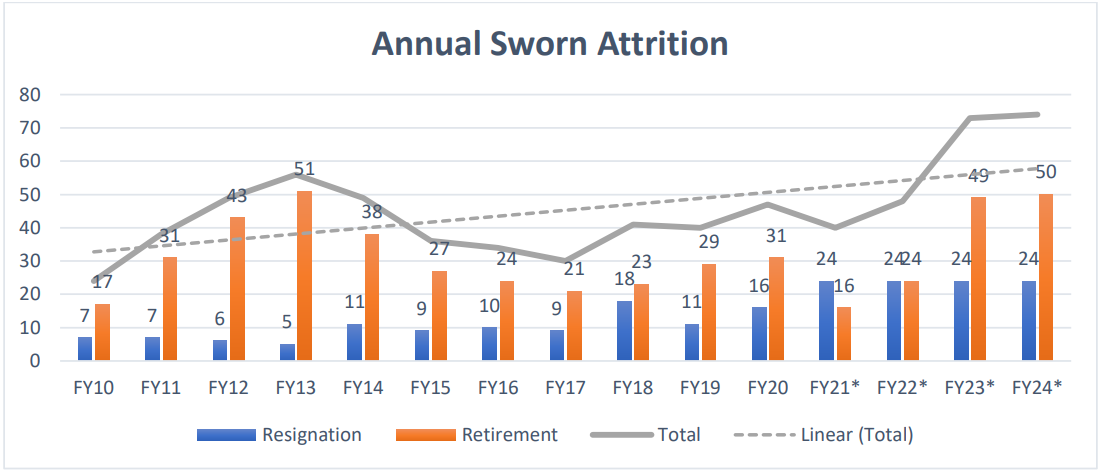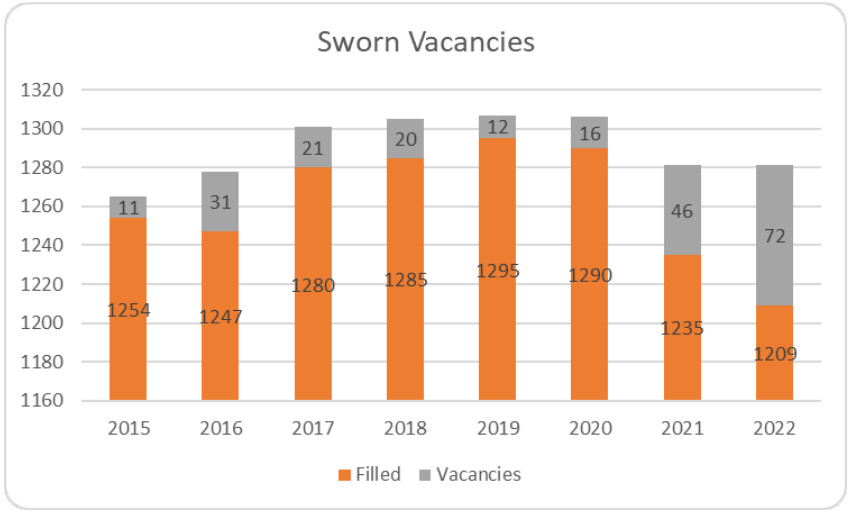By Adam Pagnucco.
Part One recounted how the county government cut sworn positions in the police department even as complaints about crime have grown. Today, let’s reveal this fact: county leaders have been warned about worsening police recruitment and attrition for years.
If the county government has a prophet about police staffing difficulties, it’s Susan Farag. A legislative analyst who has worked on the county council’s merit staff since 2007, Farag’s issue portfolio includes police, fire and rescue, the sheriff’s office, corrections and other functions related to public safety. Her periodic reports to the council are must reads for anyone who cares about crime.
Farag has issued a series of escalating warnings over the last four years about police staffing and attrition. Consider the following three quotes from her packets.
As stated above, MCPD plans on having two recruit classes in FY20, with 22 recruits each, for a total of 44 for the year. These recruits address attrition only, and do not increase the size of the sworn complement. MCPD has advised that the ideal number of recruits is 37 in each class, and it plans to proactively push to recruit that number for the first recruit class in the summer.
In 2019, county agencies averaged 2.8 officers per 1,000 residents, and suburban jurisdictions averaged 2.5. While per capita staffing is just one measure of police department strength, it is important to note that MCPD’s per capita staffing has remained about 1.2 for the past 16 years.
The chart below shows the number of officers lost each year to resignation and retirement. The Department has long been experiencing an upward trend in attrition that is increasingly difficult to keep up with through recruitment. Attrition by resignation had been budgeted at one Officer per month for many years, more recently increasing 1.5 Officers per month, and now the Department expects two officers per month to leave. Retirements are projected to significantly increase in the next few years as more officers enter the Discontinued Service Retirement Plan (DSRP).

Last year, Farag issued a dire warning that represented the culmination of trends she had been following for years. What follows is an extended excerpt from her packet of April 21, 2022 with a concluding comment following.
***** Beginning of excerpt *****
The Department currently has an authorized sworn complement of 1,281. Of these, 72 positions are currently vacant (see attrition chart on ©13). It has 731 authorized civilian professional staff positions, with 106 vacant. The recommended budget funds two recruit classes, with a total of 47 recruits for the year.

The attrition rate remains high, averaging about six departures a month through the end of FY22. The budgeted recruit classes are far too small to address current vacancies, particularly since recent recruit classes have had about 15 recruits each. If the Department cannot increase both recruitment and retention, it faces a 223-officer shortage by 2025.
Police shortages have multiple detrimental effects, both on public safety delivery and on the officers themselves. Police must prioritize responding to calls for service, and in 2020, officers responded to more than 185,000 calls and maintained an average 8:40 response time. If calls increase to their pre-pandemic levels, Officers will be stretched even thinner. They will have less time to spend on non-enforcement community engagement—a best practice for strengthening relationships with residents and businesses. Failure to build those relationships can contribute to a cycle of eroding trust, increasing crime, and fewer solved cases. Lack of staffing also places significant stress on the remaining officers, who are asked to work overtime, and when no one volunteers, they are increasingly placed on mandatory holdovers. As discussed in the Committee worksession on Police Staffing, staff shortages could also exacerbate community concerns with police encounters. Relying too much on officer overtime use, for example, is associated with increased community complaints.
Council staff is also concerned about how the staff shortage impacts reform implementation. Staff shortages further tax the limited training and policy resources within the Department. It takes both staff and time to alter policy and training rapidly and effectively. The Department has been given more than 20 reform mandates since the Summer of 2020, which they are implementing, but even good change creates stress on staff and operations.
The recommended budget adds 24 new positions (22.6 FTEs) at a cost of $1.4 million. Three of these are sworn positions.
***** End of excerpt *****
Let’s connect the dots. Over the last few years, county leaders have cut sworn positions in the police department. They removed officers from schools before sending some of them back in. They established a task force and an advisory commission that have recommended reducing both the number and the authority of police officers. The result of these actions is rising complaints about crime and a full-blown staffing crisis.
It’s worth asking how bad crime really is in Montgomery County and soon I will have a deep dive on that issue. But in the meantime, it’s time for county leaders to change course on police staffing. If we want to preserve the county’s quality of life, we must restore the police department starting with the operating budget this spring. County residents are increasingly making it clear that failure to do so is unacceptable.
